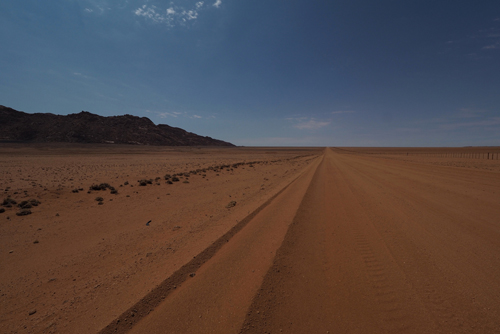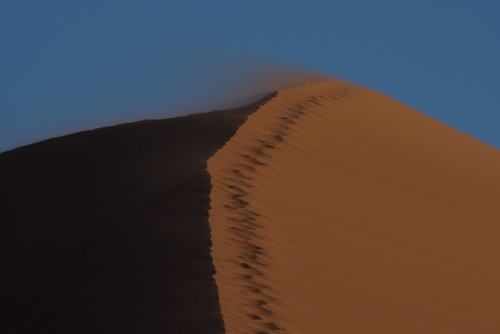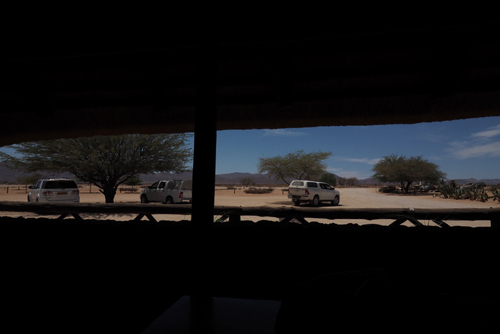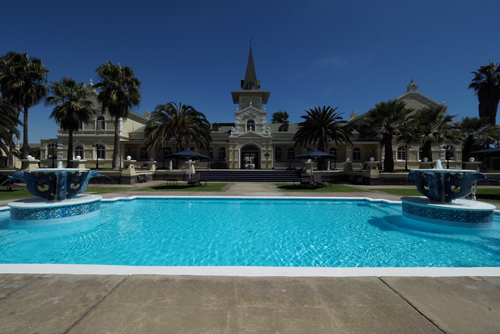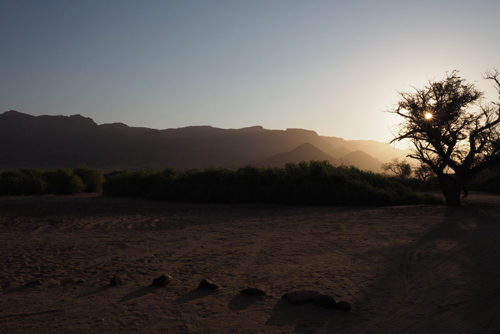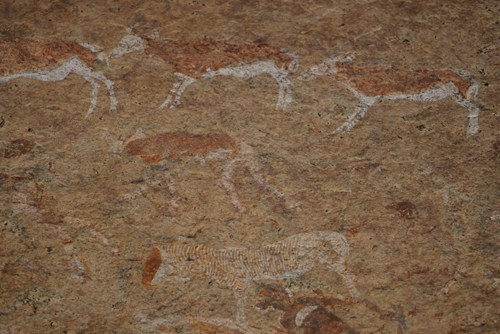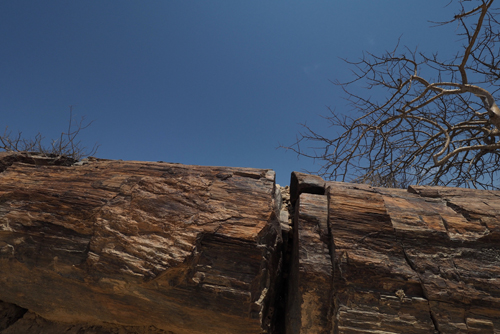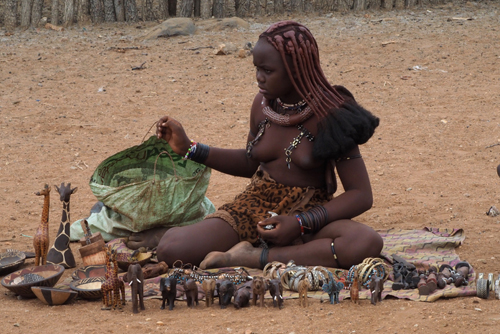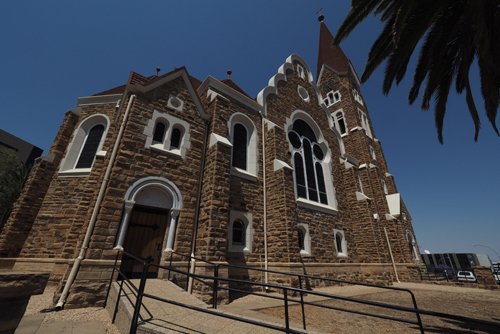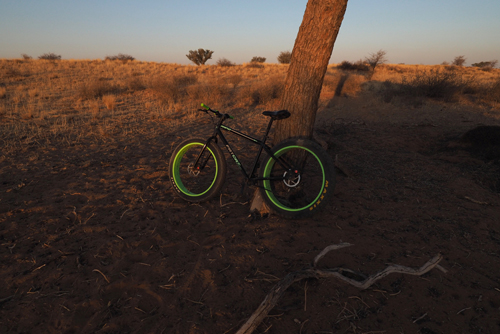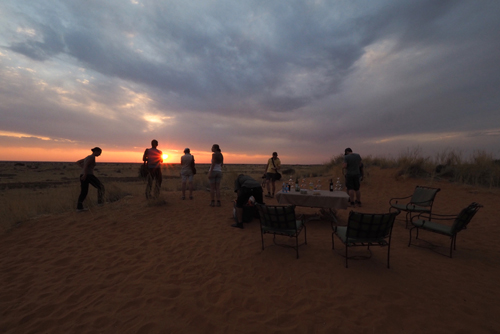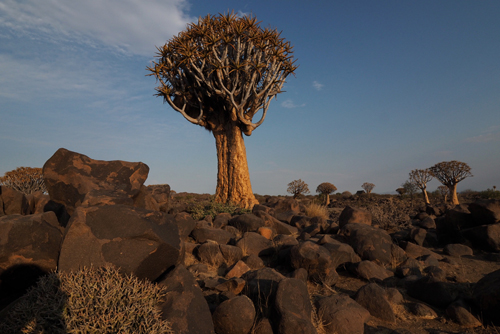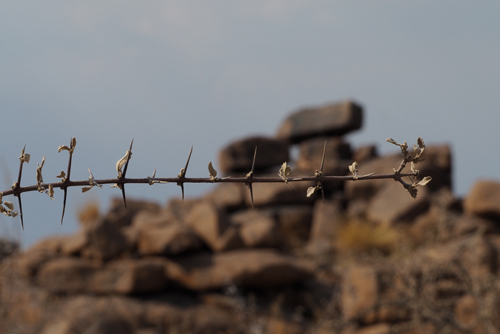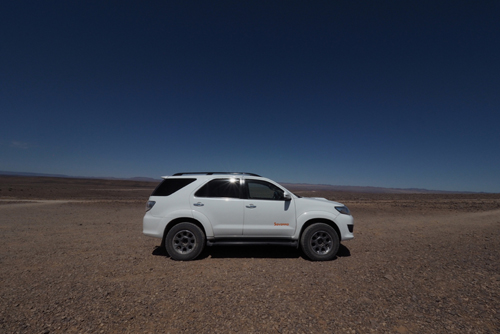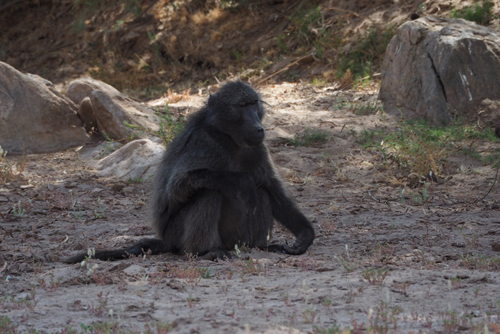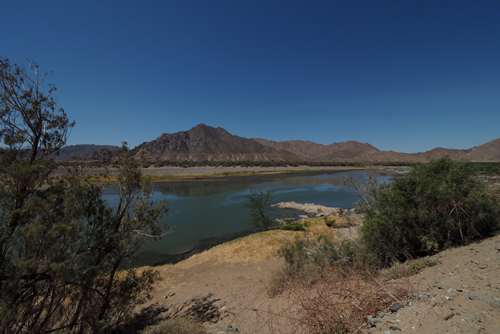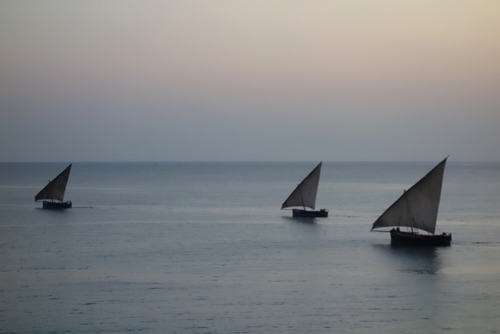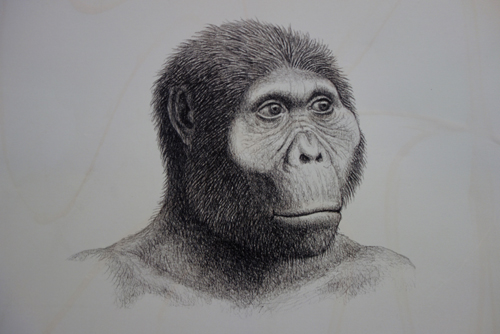Day 10, October 20: Helmeringhausen.
Being located on a working farm there isn’t much to see around the Helmeringhausen Hotel. We therefore, on the suggestion of the hotel proprietor, made a short road trip on our day in the area.
This turned out to be around 250km.
This was a circuit from Helmeringhausen down the C13 to the D707 then clockwise back via the C27.
The countryside was varied, starting with outcrops of boulders along the C13, through red desert along the D707 and then past the Tirasberg Mountains. At the junction with the C27 we headed east again, back to Helmeringhausen.
The mountains certainly influenced the weather as there was a build up of clouds and virga (rain falling but evaporating before reaching the ground) on the higher peaks.
Our constant companion, while driving on the gravel roads, has been a rooster tail of fine dust.
This changes colour according to the material the road is built from.
We have had reds, light grey, dark grey and black.
It gets into everything.
The Helmeringhausen Hotel boasts ‘The best apple cake in Namibia’ and they have T-Shirts, and a sign out the front, promoting their claim. Yet it’s never the dessert that’s part of the evening’s fixed menu.
You have to order it separately, at an extra cost of course.
Don’t you just love marketing.
What’s not promoted and a missed opportunity for the hotel is the ‘Sundowners’ walk. Just behind the hotel is a hill with a well laid out path to the top. There you get great views of the surrounding landscape and, more importantly, the setting sun.
There were six of us up there the night we went, all wishing we had taken a drink to celebrate the sunset.
I am sure the hotel could have provided a bar service, as well as snacks.
After all there was no shortage of chefs.
Day 11, October 21: Helmeringhausen to Sossusvlei.
We drove north up the C14 then turned west on the C19 towards Sossusvlei.
Again there was a dispute between the TomTom and MapsME, in regard to the distance we had to travel.
This time the TomTom won.
Sossusvlei is in the Namib Desert, one of the world’s oldest. It stretches for nearly 1,000km along the Atlantic coast.
Sossusvlei is one of the easiest places to access the desert and our hotel, the Sossus Dune Lodge, was surrounded by it.
There was a rocky ridge behind our room and a vast expanse of the Namib Desert in front.
At check-in we received yet another baboon warning, telling us not to leave any windows or doors open. After our experience at the Ngorongoro Crater Conservation Area, everything remained shut.
Why we were booked into the honeymoon suite I have no idea. It was about as far away from the office, restaurant and bar as you could get. Our area was huge and it even had a swinging day bed at one end of the wide veranda.
Being in the heart of the desert the winds ebbed and flowed, gently rocking our day bed. This was a wonderful vantage point to take in the spectacular desert scenery.
In the late afternoon we headed out to explore the famed dunes of the Namib Desert, especially Dune 45.
This is what’s called a ‘star dune’ and gets its name from the fact that it’s 45 kilometres on the road that connects the Sesriem Gate and Sossusvlei. It’s made up of 5 million year old sand that was accumulated by the Orange River and came from the Kalahari Desert, then blown into the Namib Desert.
As the sun sets, one side of the dune is thrown in shadow, while the other side glows bright orange.
I can understand why Dune 45 is the most photographed dune in the world.
As tourists we tread gently.
Whatever country you travel in, it isn’t yours, unless you live there of course, you therefore need to be mindful of offending people.
Some tourists believe it’s their right to demand. It could be what they want to eat, what language they want to speak, or even where they want to sit.
These people are rude.
We witnessed one such couple rearrange a table for four, at a window seat, just to suit themselves.
Everyone in the restaurant looked on in disgust. Especially those who had taken the tables for two, that were not by the window.
Ironically the light vanished within minutes of them sitting down, so they had no view anyway.
As it turned out the couple were celebrating a seventieth birthday and the restaurant staff made a big fuss, giving him a very large birthday cake.
It was so large that they shared it with the other diners in the restaurant.
We felt that our judgement of them may have been a little harsh.
That’s until we bumped into them again the next day – they were just as obnoxious.
Our first impression was the right one.
Day 12, October 22: Sossusvlei.
We ordered a packed breakfast from the hotel and headed out just before dawn.
It was hazier, with more cloud around, so the photos weren’t as striking as we had taken on the previous evening.
When we reached the end of the 60km stretch of paved road, we went for a walk in the dunes.
Despite the fact that the car park was full of people, 4WDs, buses and safari vehicles, the dunes were surprisingly quiet.
The light had improved and there was a real contrast between the orange dunes and the bright blue sky.
Our only companions were three Oryx grazing in the distance and the occasional lizard scurrying over the sand.
Our next move was a mistake.
We took the shuttle down a 4WD track to see more of the dunes.
So did everyone else.
There were hundreds walking and climbing over the dunes and along the dry river bed.
It was like Kurfurstendamm on a warm summer’s evening, complete with the chatter of Deutsch.
Then, when we decided to return to our car again, so did everyone else.
The shuttle bus drivers never stopped at the same spot, to drop-off and pick-up passengers.
This meant that random groups of people gathered where the last bus made a drop-off.
However they never stopped there.
There was a further complication, in that some of the buses went an extra kilometre down the road to the end of the track – so we never knew where they were going to end up.
Again there was no obvious pattern, so we decided to get on any bus we could, and stay on it until we eventually got back to the car park.
This strategy worked and we had the bonus of doing the full circuit and seeing the last of the Sossusvlei Dunes.
With all the confusion I wished I had taken the Toyota and driven myself, that’s until we saw two 4WDs up to their axils in sand.
Our hotel, the Sossus Dune Lodge, was one of the first lodges to be developed by the Namibia Wildlife Resorts in 2007.
It is literally perched above the Namib Desert.
The lodges, walkways, restaurant and even the pool are all built on stilts. The only footprint left by the lodge are the holes in the desert floor.
Just as we arrived back from our drive in the dunes, a tour bus came out of the dust and heading for the Sossus Dune Lodge.
At dinner we found out it was a Chinese tour group.
Now Chinese tourists are very valuable to a hotel, they can also can be very disruptive, as ‘they want it and they want it now.’
There were 24 in the group and they returned to the restaurant at 8pm, after a sunset tour, looking to be fed. It took well over an hour for them to be served, yet they consumed their meals in less than 20 minutes.
There has to be a more efficient way to service their needs.
If the Namibia Wildlife Resorts want the Chinese tourists they’ll have to do better than that.
Day 13, October 23: Sossusvlei to Swakopmund.
Continuing on the C19 we now headed north.
About 70km from Sossusvlei is the tiny town of Solitaire.
It was suggested that we stop there as they have a good bakery and an espresso machine.
The cake was better than the coffee.
There was no parking in front of Moose McGregors Desert Bakery, so everyone parked under the two trees that were conveniently out the front.
A much better option, considering the temperature was now around 34°C.
It was a rather long, 375km, drive from Solitaire to Swakopmund and the terrain became flatter and dryer with little vegetation.
We hit the Atlantic at Walvis Bay and drove to the Walvis Bay Lagoon to see the flamingos.
There were a lot.
They were the Lesser Flamingo and not surprisingly, smaller in size to the Greater Flamingo.
When we got out of the car to take some snaps, we found that the temperature had plunged about 20°C.
Walvis Bay plays an important role in the oil and gas industry as well as being a vital port for Namibia. It is also growing in tourism and is the second most important coastal resort town next to Swakopmund.
When we arrived in Swakopmund it was as quiet as a church mouse on a Sunday. About the only thing that was slower was the internet in our hotel.
After wandering around the town and finding nothing open we returned to the hotel.
Not surprisingly it was very busy, as everything else was shut.
The Anchor Point Restaurant, within the Swakopmund Beach Hotel, has an interesting history.
It’s named after three rather ornate brick structures that are just outside the hotel. These were anchor points for an 86 meters high communications tower that was used by the Germans during WW1. This transmitter was a vital radio link to Lüderitzbucht, Windhoek and Berlin. In 1914, when war broke out in South West Africa, the local German military destroyed the tower, fearing it would fall into enemy hands.
Day 14, October 24: Swakopmund.
Our hotel was right on the junction of the Atlantic Ocean and the Swakop River.
The river was the boundary between the town and the desert.
On our first morning we couldn’t see much as the fog had rolled in and visibility was down to a few hundred metres. This is caused by the hot desert air running headlong into the sea breezes from the cold, moist Atlantic.
Swakopmund is the second largest town in Namibia and the resort capital. It remains cool when the rest of inland Namibia boils.
There is 1,570 kilometres of coastline in the west, stretching from the Kunene River in the north to the Orange River in the south. The coastline north of Walvis Bay is referred to as the Skeleton Coast and most of it is desert. The entire Namibian coastline has been designated as a national park. In fact the Namibian government has become a trailblazer by using tourism to fund conservation.
Walvis Bay and Swakopmund are an oasis of cool sea breezes and Atlantic swells in the otherwise dry south.
We spent the day walking around Swakopmund, meandering through the wide ordered streets.
It was good to get some exercise – we walked over 14km that day.
The fog lifted by late morning but then settled again. However by the late afternoon it was gone completely and the sky was blue.
The air was still chilly and we kept our jumpers on.
There are number of good examples of Colonial German architecture from the early 1900s in Swakopmund.
There’s the Evangelical German Lutheran Church, built in 1912. Just over the road the Namib High School, built a year later in 1913.
The best for me was the former railway station, or Bahnhof, built in 1901 and now the five star Swokopmund Hotel.
The large in ground pool sits on platform one, where the locomotives once chugged in and out of the station, bringing holiday makers from Windhoek.
In the evening we decided to go German and visit the Swakopmund Brauhaus.
We were lucky we set off early as the place was fully booked.
Monday night was almost as quiet as Sunday and there were only a few places open.
Those who knew had booked the Brauhaus in advance.
We did get a table but were told we had to be out in an hour and a half. However with some clever table manipulation by the staff, we got to stay longer.
The Swakopmund Brauhaus was very German, like a small slice of Bavaria in the heart of the Namib Desert. They served hearty German fare and a great variety of German draught and bottled beer as well as German and South African wines.
Day 15, October 25: Swakopmund to Brandberg.
The sea mist was back the morning we left Swokopmund.
It is truly a different part of Namibia, in all aspects. The architecture, the people, the Atlantic and of course the weather.
The drive to Brandberg White Lady Lodge was relatively easy, although there was some confusion as to where it actually was.
For the first 70 km after leaving Swokopmund we were on a sealed and then a salt road.
We had experienced this surface coming into the coast at Walvis Bay and it was a surprisingly smooth ride.
Namibia has more than 44,500 kilometres of roads and they are regarded as some of the best in Africa. There are only 288 kilometres of salt roads, which are limited to the Atlantic coast, inside the mist belt. These road are constructed from concentrated salt water and a gypsum-rich material.
Over half the roads in Namibia are a standard gravel road, covered with imported gravel.
When we arrived in Brandberg White Lady Lodge there were signs warning us of the dangers of Desert Elephants – the place is apparently famous for them.
Was this going to be the same as Sossus Dune Lodge, where were warned about the Baboons but never sighted one?
The White Lady Lodge is named after the famous cave paintings that were discovered in 1918 by the German explorer Reinhard Maack. They are in the Brandberg Mountains, not far from our hotel.
There is significant conjecture as to the origins and authorship of the paintings. The current theory is that they were created at least 2,000 years ago by the bushmen or San People.
The ‘White Lady’ is not a woman at all but a medicine man, with painted legs and performing a ritual dance.
In every place we have stayed the layout, style and ambience have been unique. The Brandberg White Lady Lodge was no different.
It was divided into three distinct areas: The restaurant, bar and swimming pools were the hub, then about 200 metres into the bush were the stand alone chalets, where we were staying. There were seven of these, spread throughout the bush and all under trees. The trees kept the room cool and also provided shade for our car. Within this area there were also two sets of seven rooms apartments.
The third area was for the campers. There was a combination of tented camps and camp sites. These were set around the dry beds of the Teisen and Ugub Rivers.
All this was set against the backdrop of the Brandberg Mountains.
Brandberg or Fire Mountain is Namibia’s highest peak, with its zenith, the Königstein or ‘King’s Stone’, 2573 metres high.
It was a hot, dry and dusty environment, that was both hostile and stunning.
Power for our chalet came from a 12 volt battery that’s charged by a solar panel that was just outside. While the hot water was provided by a solid fuel boiler, that was behind a high stone wall next to our chalet – it was lit twice a day.
There was no WiFi or connectivity of any sort. If you needed to charge your devices you had to take them to the main lodge area, where there was a generator.
Dinner was served at 7:30 so we went up to the lodge to have a pre dinner drink at the bar.
We were alone.
Everyone was up on the hill, behind the bar, at the ‘Sundowners’ seats.
We didn’t bother. I think we have become a little blasé about sunsets, as we get one most nights in Sandringham.
Day 16, October 26: Brandberg.
In the morning we headed out to visit the site of the White Lady rock art.
This is only one of a reported 40,000 individual pieces that are on Brandberg Mountain.
The art in the caves vary from 2,000 to 5,000 years old.
The White Lady was name as such by the French anthropologist Henri Breuil in 1929, believing the art could have been painted by Phoneticians from the Mediterranean. The headwear was very similar to that worn by Egyptian women.
This theory has since been discounted.
The organisation of the cave walk was very well done. Firstly we were checked in and had everything explained to us. Then we were given a guide for our 45 minute walk to and from the cave.
Marcus could talk and didn’t stop chatting the entire time.
On the way there we were in constant lookout for the elusive Desert Elephant.
Native Africans have a very well developed fear of elephants, more than any other animal it seems. We noticed this in Kenya, Tanzania and now in Namibia.
There’s were plenty of smelly signs that elephants were in the area and it was only when we arrived at the cave did we actually see them.
They should be really called ‘Rock Elephants’ as they were perched on a rocky ledge, over the dry river bed that was opposite the cave.
We heard them before we saw them, as they were snapping off tree branches for food.
All along the track to the cave the trees had also been devastated by the hungry mammals.
Camp gossip told us that there might be more elephants up the dry river bed, not far from the lodge.
So in the afternoon we headed off, hoping that my limited 4WD experience would get us through the sandy river bed.
We gave up on the elephants after travelling 6km up the river and turned around. Then we sighted two on the river bank – one was giving himself a sand shower, while the other was asleep under a tree.
Dinner is a fixed menu with an entrée, main course and desert.
There is little variation.
There was a family of seven, mum dad and five children, ranging from five to fifteen.
All the family were served the same meal as everyone else and it was interesting to watch them divide up the food. In the end all the appetites seemed to be satisfied.
I guessed they had done this before.
At the end of dinner the staff put on a performance. On our first night there were fifteen of them and on our last, seven.
The size of the ensemble is determined by how many guests they have to serve.
Day 17, October 27: Brandberg to Damaraland.
There was no water in our chalet on our last morning. We went outside and discovered our hot water service lying on its side, with all the connections broken.
After reporting it to the staff, we were told to shower at one of the campsite facilities.
When we got back to our room after breakfast there was a guy there repairing our broken water heater.
He explained that the damage was done by an elephant looking for water – they can smell it.
Apparently this happens all the time.
In the end we didn’t see the Desert Elephants in the camp but knew that they had been there.
It was a long drive from Brandberg to Damaraland, as we had to make two diversions.
One to the Petrified Forest and the other to the San rock engravings at Twyfelfontein.
The Petrified Forest is an area of land where 280 million years ago large pine trees were washed into Namibia from Central Africa.
They were subsequently covered by alluvial sand. Deprived of oxygen, they couldn’t rot and over millions of years underwent silicification, fossilised, and subsequently turned to stone.
Almost of as much interest as the trees, was the Welwitschia. This is ancient plant that taps water from the coastal fog. If can live for hundreds of years and is considered a living fossil.
The rock engravings at Twyfelfontein date back 2,000 to 2,500 years but the site has been inhabited for 6,000 years.
The area was made Namibia’s first UNESCO World heritage site in 2007.
The most famous is the ‘Lion Man’ engraving. This depicts a lion with five human like toes on its feet and one on its tail.
This is believed to be a depiction of a Sharman or Witchdoctor’s dream of his afterlife form.
The image of the lion is a cross between an animal and a man.
A lot of the rock art was created to be as much educational as spiritual. Many engravings were designed to teach current and future generations about the bush, animals and where to find water.
They were like a ‘blackboard’ of information on learning about nature.
There was one particular engraving of an ostrich with four heads. This was a form of animation that depicted the ostrich standing then lowering its head to drink. The direction the bird faced indicated where water could be found.
The name Twyfelfontein means ‘Doubtful Spring’ in Afrikaans. It was used by a German settler, David Levin, to describe the place. He didn’t believe that the water from the local spring could sustain his cattle. Levin’s friends started to call him David Twyfelfontein or David Doubts-the-spring.
The name stuck.
Because of our diversions it was 3pm before we started the drive to Darmaland. And as usual there was confusion between the TomTom and MapsME as to how long it would take.
However the difference wasn’t as large this time.
It was going to be a long drive whatever device we used. And all of it, apart from two short stretches, was in gravel roads.
The benefit of travelling on dirt roads is that you can see vehicles coming, way before they get to you. The plume of dust is visible, even if the car isn’t.
We covered about 500 kilometres that day, so my evening beer was very welcome.
Day 18, October 28: Damaraland.
We were staying at Toko Lodge in Damaraland. Now Toko is the local word for Hornbill and they were everywhere.
Their squawk woke us up at five and just to make sure we were awake, they then knocked on our window at seven.
There is plenty of food for them, both indigenous and provided, so they naturally hang around the hotel.
The birds and animals took it in turn to eat at the feeding points.
In the morning the Tree Squirrels were there, they were replaced by the Hornbills who grazed all day. In the evening the Guinea Fowls then waddled in for a meal.
After breakfast one of the staff told us that there was a problem with our car.
Fearing the worst we went to have a look. As It turned out we only had a slow leak in the right rear tyre and it was soon repaired.
The staff operated like a Formula One pit crew. The problem tyre was soon off the Toyota and replaced with one of the spares. Then they found the cause, it was part of a valve shaft that had imbedded itself through the rubber. Once that was fixed the original tyre went back and then they gave our vehicle a bonus car wash.
All this cost us the equivalent of A$5.
As it turned out this was the only issue we had in the entire 4,800 kilometres of our Namibian road trip.
Just down the road from the lodge is a Himbas Village and we decided to do the village tour.
The Himbas people actually come from an area that’s about 300 kilometres north of Damaraland and that’s where they graze their cattle.
Traditionally they were nomadic but these days the women and children live in the village, while the men stay with the cattle.
The Himba are traditional people who escaped being converted to Christianity by the zealots of the German Colonial Missions.
The women are topless and don’t bath. They use a combination of perfumes and smoke, infused with herbs, to cleanse and beautify themselves. They also rub ochre on their skin as another form of beauty treatment.
Their traditional clothing, like belts, anklets, loincloths and headwear all holds spiritual or social significance.
There were single women, mothers, babies, young children and an assortment of small farmyard animals. Often some of the teenage girls have to stay at home, rather than go to school, to learn the Himba ways.
I only sighted one male – I guess the rest were off tending the cattle.
Some of the tourists came laden with Chupa Chups for the children. It wasn’t long before there was a small white stick hanging out of every mouth in the village.
I am sure that that the kids could have been given a more appropriate gift than sweets.
At the end of our visit we were given a very enthusiastic performance of singing and dancing as well as an opportunity to buy souvenirs.
We bought a small carved African Elephant. The tusks were made from the lollypop sticks, so at least they were being put to good use.
